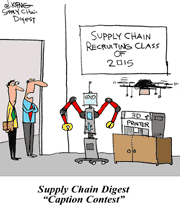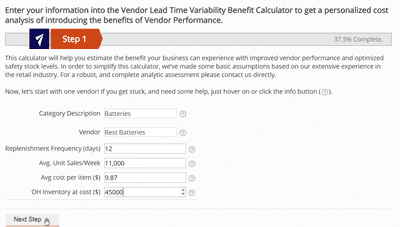 |
January 29, 2015 - Supply Chain Flagship Newsletter |
 |
| FEATURED SPONSOR: AMBER ROAD |
||
 |
||
|
||
 |
|
|||||||||||||||||||||||||||||||||||||||||||||||||||||||||||||||||||||||||||||||||||||||||
I made some pseudo predictions myself for 2014, and I admit I was dead wrong on one of them - that natural gas powered trucks would really take off in the US, and we would see many more announcements like the one we received from Lowes in 2013. (See Lowes to Expand Natural Gas Truck Program with Complete Conversion at Texas Distribution Center.) The reality was that while nat gas trucks sales rose decently, they were far short of initial expectations, and we didn't see many Lowes type announcements in the logistics area at all. I still believe in natural gas trucks, but the path to get there economically is just tougher than I thought.
Gene Tyndall of Tompkins International is back with predictions for 2015, and he first takes a victory lap of sorts by noting that his 2014 predictions for key supply chain trends were mostly on the money, many around the theme that 2014 would be the "year of the customer." For 2015, Tyndall believes on the supply chain technology front that "Cloud-computing will go mainstream. The speed to execution, lower costs, higher service levels, and preservation of capital related to Cloud-based applications is so compelling that more and more companies will migrate to this path."
Extending a prediction he made in 2014, Tyndall believes there will be a lot of focus again this year on "operations strategy," which in part involves tightly linking supply chain capabilities to company strategies and objectives. That said, Tyndall believes not enough supply chain leaders "are focused on building the precise capabilities that an operations strategy calls for. Consequently, investments are not tied directly with business value statements, are not necessarily what is needed to compete, or do not satisfy customers as well as their own cost controls."
A new guru this year is George Stalk of Boston Consulting Group, who has authored a number of books, including one of my personal favorites, "Competing Against Time." Stalk sent us some excellent thoughts on what will be the key issues that supply chain professionals will face in the coming year.
That includes dealing with a "two-speed world." Stalk says that "The explosive growth of the middle class and the rise of new, large cities in developing economies place new demands on supply chains. For example, China has 90 cities with middle class populations of more than 250,000. By 2020 this number will grow to more than 280 cities - each needing to be supplied. New supply chains must be built to serve slower growing, developed economies and fast growing ones."
He also says supply chain leaders are moving towards "deep collaboration." What does that mean? I might call it multi-tier collaboration. Stalk says that "For a few leading edge companies, deep collaboration can be seen to mean establishing close interactions at multiple levels of your relevant supply chains - at minimum including your suppliers' suppliers and your customers' customers."
Interesting - can we really get there?
Our good friend Mike Regan of TranzAct Technologies is also back with as usual some excellent thoughts on the logistics sector. He predicts that trucking capacity will remain tight again in 2015, and that this "will result in higher rates in the TL and LTL sectors and force shippers to reevaluate their negotiating strategies within their core carrier network."
He adds that "Savvy shippers will be focused on working with their core carriers to lock in capacity at predictable prices versus selecting the carriers with the lowest possible rates. Overall, expect carriers to be more aggressive in using their pricing power to cull, or get rid of the least profitable freight and replace it with higher yielding shipments with better margins."
He also says to expect more "dimensional weighing" programs from LTL carriers this year, following in the wake of UPS and FedEx - and that means higher cost for shippers.
He says that "As more LTL carriers utilize technology and "dimensionalizers" to determine how much space every shipment is taking, the National Motor freight Classification System will become less important. LTL carriers want to be compensated for the size and weight of your shipments and will therefore scrutinize FAK based rate structures to make sure that they accurately reflect the material being shipped."
Our friend David Schneider, a former logistics executive now running his own consulting firm, is also back and as usual with some provocative thinking.
He first notes something I wish I would have thought of, which is that "Lower fuel costs will impact the adaptation of computer-based route planning. Fuel cost reductions are the main driver most operators look at to justify routing software."
Schneider also says that despite low oil prices, "warehouse operators will still face energy cost challenges, as electrical costs will increase. Coal fired operations that don't meet the new regulations will close. The others that do make the upgrades will pass the costs along in the price per kilowatt. Localized natural gas plants may help ease the pressure on the distribution network infrastructure, but the capital needed to improve the transmission network infrastructure may prove to drive up the prices charged for peak load. Smart cold storage warehouse managers are going to look for ways to trim away at electrical costs." Marc Wulfratt is president of consulting firm MWPVL International and knows a lot about a lot of things, starting with DC automation and over the last few years becoming one of the most knowledgeable observers of ecommerce generally and Amazon.com specifically.
Wulfratt this year mostly focused on key trends that will impact the supply chain, and he is among those who see big troubles from current demographics changes. He says the trucking, manufacturing and warehouse sectors are all battling issues relative to their workforces becoming older.
He also notes that "In 2015, the U.S. age dependency ratio (ADR) will be 52.5% which means that the percentage of people that are younger than 15 and older than 64 represent 52.5% of the population. In 15 years-time, the ADR ratio in the United States is expected to increase to 62.8%. This means that 37 people out of 100 will be working and paying taxes to support the 63 who are not working."
Yikes! With the supply of workers down, wages will go up, though we can all agree the impact of this shift will be much greater than just wage pressures.
Finally, we heard this year from Chris Gopal, long-time supply chain consultant also now working at the the Drucker School at Claremont in California.
Gopal provide us with what he sees as key trends that will drive supply chain initiatives in 2015. One is around "ease of doing business," which he says will drive "initiatives along the entire Customer Experience Life Cycle, from deciding on a product or supplier through ordering, configuration, pricing, payments, service and returns. An important part of this is the omni-channel fulfillment and "last mile" fulfillment necessary for ease of doing business, customer convenience and costs."
Another key trend is around "customer groupings (segmentation) and differentiated service offerings." He says that "The realization that customers today are connected and demand increasing services and personalization is driving the groupings of customers by requirements and geography so that differentiated and separate service offerings can be provided. Key considerations here are costs-to-serve and profit by customer grouping."
I am out of space, and we barely scratched the surface. Again, analyst predictions for 2015 here next week. Full text predictions from our gurus next week in our OnTarget newsletter. Would love to hear any prognostications you have for the coming year. Any reaction to our 2015 guru predictions? Have any predictions of your own you can share? Let us know your thoughts at the Feedback button or section below.
|
||||||||||||||||||||||||||||||||||||||||||||||||||||||||||||||||||||||||||||||||||||||||||
|
||||||||||||||||||||||||||||||||||||||||||||||||||||||||||||||||||||||||||||||||||||||||||
|
||||||||||||||||||||||||||||||||||||||||||||||||||||||||||||||||||||||||||||||||||||||||||
|
|
|
YOUR FEEDBACK
As promised, more emails from our First Thoughts piece on What Would You Tell Accountants about Supply Chain? Parts 1 and 2.
There were such a number of good ones, we are again not going to select a Feedback of the Week, but will rather just publish a few of the better ones thins week and next.
Feedback on What Would You Tell Accountants about Supply Chain?:
In 2013, I gave a talk to the Illinois CPA Society on inventory. I asked myself the same question that you did - how in my case can I make inventory interesting to CPA's and what should I suggest they do to influence it. |
||
I've been using a version of the DuPont model since the seventies. The version I was exposed to was called the Strategic Profit Model (SPM), but it is the same thing. I believe I was first exposed to it in a seminar put on by Dr. Bud LaLonde of Ohio State. To me, it is one of the most valuable tools around, both for finance people and for those of us in supply chain.
To an extent, I've had similar experiences to yours where I got a lot of blank stares from finance people. When I asked if they were familiar with the model, many have indicated they were unaware of it. I think one of the problems, is that the model has typically been presented as a generic model, showing relationships, but void of any data. That makes it abstract. However, when you load it with real data, the financial picture of organizations comes into view in an easily comprehensible way. In one company I worked for, we shared detailed financial information with all of our employees. Using the SPM, we not only shared the data with the employees, but they were able to track their individual job/work efforts all the way to Net Profit and ROI. They got it!
David Armstrong
|
SUPPLY CHAIN TRIVIA ANSWER
Q: What share of total US imports of manufactured goods come from China?
A: Just under 24%.
| © SupplyChainDigest™ 2003-2015. All Rights Reserved. SupplyChainDigest PO Box 714 Springboro, Ohio 45066 |
POWERED BY: XDIMENSION
|








